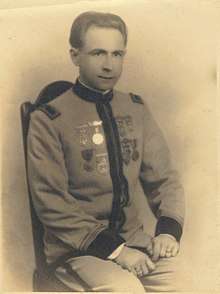Caesar LaMonaca

Caesar LaMonaca (1886–1983) was a musician, prolific composer and band leader who worked mostly in California and Florida throughout the 20th Century.
Early life
As a child in San Severo, Italy[1] he found he had an affinity for music, like his older brother Joseph. By age nine, he became good enough as a French horn and trumpet player that he was able to join a professional concert band touring Europe. Joseph LaMonaca was already playing flute in the Philadelphia Symphony Orchestra and was able to help Caesar find a gig with Giuseppe Creatore's Italian Band. That launched Caesar's career in America. He traveled throughout the U.S. and began conducting the Creatore Band at age 16.
Career
After World War I, Mr. LaMonaca settled in California, where he played everywhere from Santa Barbara to San Francisco and had recurring gigs at the Greek Theater in Berkeley.[2] After touring with various ensembles, including Ellery's Royal Italian Bands, he moved to Miami in the early 1920s to conduct a band at the Roman Pools and by 1926 was director of the Hollywood, Florida municipal band.
Soon LaMonaca was working with the local Boy Scouts and helped stand up their drum corps, as he did later in Miami as well.
In 1926 LaMonaca accepted an offer to replace the famed Arthur Pryor for waterfont concerts in Miami, but that season was interrupted by the Great Miami Hurricane. LaMonaca's Hollywood band immediately began to play at area hospitals for victims of the hurricane.[3]
After Miami rebuilt the Bayfront Park Amphiteater, in 1927, his band gave concerts there for the next 50 years.[1] In 1929, he became director of the Harvey Seeds American Legion Post Drum and Bugle Corps, which he led for twenty years.
Under his musical direction Harvey Seeds won three national championships and a number of other accolades.
In 1930, LaMonaca volunteered to conduct the 265th Coast Artillery Band of the Florida National Guard, a military unit which was the predecessor of today's 13th Army Band, Florida National Guard. This is the only Florida band that survived the reorganizations of the military after WWII. LaMonaca retired from the unit in 1941, as the unit was federalized for active duty. The band served in Texas and Alaska, but LaMonaca noted in an interview that the Army didn't pay enough to keep up his familial responsibilities.
In 1931, he formed the Greater Miami Boys Drum and Bugle Corps, which he headed until 1955. That drum corps traveled the world and won several competitions, apart from the Harvey Seeds, Legion corps. At one point the depression-era WPA was used creatively to assist out-of-work musicians and as many as 14 teachers were paid to assist the drum corps, which swelled to over 360 members.[4]
LaMonaca is also cited as the creator of the West Palm Beach Municipal Band, which he led until 1930.[5]
He was not only a great conductor, but an educator. From 1946 to 1955, he organized and directed a youth symphony that performed twice weekly during the summer months at the Bayfront Park bandshell while his symphonic band was on hiatus.[6] This is considered the predecessor to the Greater Miami Youth Symphony.
LaMonaca's legacy was not only that of a great entertainer, but someone who was a keystone of South Florida history. His concerts remain in the memory of many Miamians who didn't have television and went down to the park on Friday and Saturday nights for his concerts. His students went on to both teach and perform. His students in the Greater Miami Boys Drum Corps included Wade Buff and Gene Adkinson, who went on to form The Dreamers. His own son, Caesar Lamonaca Jr, was a respected educator and French Horn player.
During his final concert at Bayfront, he fell from the podium and broke his hip.[7]
References
- 1 2 Roberts, Jack (12 January 1977). "A salute to Caesar LaMonaca, Miami music man for 48 years". The Miami News. pp. 5A. Retrieved 27 March 2010.
- ↑ "Music In Park..." Miami Herald. Apr 8, 1934. Retrieved 13 February 2014.
- ↑ Mickelson, Joan (2005). A guide to historic Hollywood: a tour through place and time. The History Press. p. 83. ISBN 1-59629-049-8. Retrieved 27 March 2010.
- ↑ Stolee, Marilyn S (1970). "The Federal Music Project in Miami" (PDF). Tequesta. 1.
- ↑ "Earl Duncan Named..." Palm Beach Post.
- ↑ Higgins, Sharon K. "Caesar LaMonaca: A Remembrance of the Bayfront Park Bandshell Concerts". memorialis.com. Retrieved 27 December 2012.
- ↑ George, Paul S. "Miami's Bayfront Park: A History". bayfrontparkmiami.com. Archived from the original on 25 February 2011. Retrieved 27 March 2010.